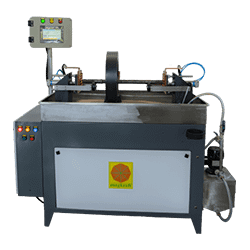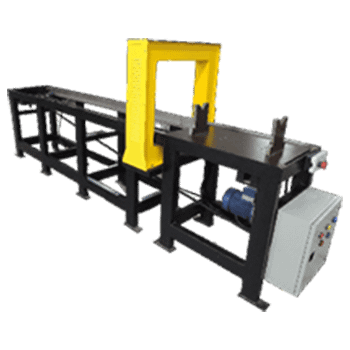Magnetic Particle Inspection of Coil Springs
Coil springs play a crucial role in the suspension system of railway bogies, contributing to passenger comfort, cargo protection, and overall rail safety. These springs absorb and distribute the dynamic forces encountered during train travel, ensuring a smooth and stable ride. They counteract vibrations, reduce impact loads, and maintain constant wheel-to-rail contact, preventing derailments and enhancing the longevity of track infrastructure.
The significance of magnetic particle testing (MPT) for these coil springs cannot be overstated. As safety-critical components, any defects in coil springs can lead to catastrophic failures, disrupting rail operations and endangering lives. MPT is employed as a non-destructive testing method to detect surface and near-surface flaws such as cracks and fractures in ferromagnetic materials. By subjecting coil springs to a magnetic field and applying magnetic particles, potential defects become visible, allowing for early identification and intervention. This proactive approach to maintenance ensures the integrity of coil springs, upholding rail safety and reliability.

The geometry of a coil spring is unique and demands a special method of magnetization.
The Coil spring needs to be magnetized in two directions perpendicular to each other for detection of defects in all directions. One magnetic field is generated by passing a current through the length of the Coil spring.
Calculation of head shot current is done as per the formula given in ASTM standards.
Head Shot Current = 20 X Diameter (mm)
In the above formula, the diameter should be taken as diameter of the rod from which the spring is made and not the outer diameter of the spring.
With this type of excitation, transverse defects in the spring can be detected.
The second magnetic field is generated by using a central conductor.
Calculation of current for this shot is done as per the formula given in ASTM standards.
Head Shot Current = 20 X Diameter (mm)
In the given formula, the diameter should be considered as the outer diameter of the spring.
Defects in the longitudinal direction, parallel to the axis of the spring, can be identified using this magnetization technique.
A bench-type horizontal machine is utilized for conducting magnetic particle testing on Coil springs. The Coil spring is positioned on the stable rollers attached to the machine. An arrangement operated pneumatically is employed to secure the Coil spring from both ends. Pneumatic clamping ensures the absence of sparks when a high current is applied to the Coil spring. The use of braided copper pads is also advised to eliminate arcing sparks.
A copper conductor, connected to a pneumatic cylinder, is utilized for the magnetization of the central conductor.

- Clean and dry the surface of the Coil spring before inspection.
- Place the Coil spring on the steady rollers.
- Apply a magnetic solution bath to the Coil spring.
- Press the ‘Cycle Start’ button.
- The Coil spring automatically clamps.
- Stop the bath flow.
- Now, the current passes through the Coil spring.
- Read the measurement on the digital metering unit.
- The Coil spring automatically de-clamps.
- Inspect the Coil spring under UV light for transverse defects. Rotate on steady rollers.
- Apply the bath again to the job.
- Press the ‘Cycle Start’ button.
- Stop the bath flow.
- The central conductor emerges, passes through the spring, and connects to the tailstock.
- Stop the bath flow.
- Now, the current passes through the copper rod.
- Observe the measurement on the digital metering unit.
- Inspect the Coil spring under UV light for longitudinal defects. Rotate on Rollers.
- Demagnetize




